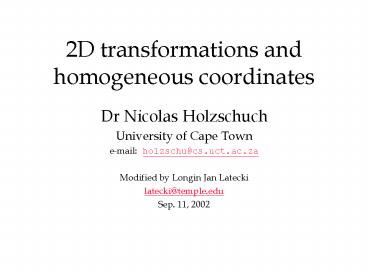2D transformations and homogeneous coordinates - PowerPoint PPT Presentation
1 / 25
Title:
2D transformations and homogeneous coordinates
Description:
From World to Window. Inside the application: application model. coordinates related to the model ... want the equivalent in World Coord. because the user has ... – PowerPoint PPT presentation
Number of Views:64
Avg rating:3.0/5.0
Title: 2D transformations and homogeneous coordinates
1
2D transformations and homogeneous coordinates
- Dr Nicolas Holzschuch
- University of Cape Town
- e-mail holzschu_at_cs.uct.ac.za
- Modified by Longin Jan Latecki
- latecki_at_temple.edu
- Sep. 11, 2002
2
Map of the lecture
- Transformations in 2D
- vector/matrix notation
- example translation, scaling, rotation
- Homogeneous coordinates
- consistent notation
- several other good points (later)
- Composition of transformations
- Transformations for the window system
3
Transformations in 2D
- In the application model
- a 2D description of an object (vertices)
- a transformation to apply
- Each vertex is modified
- x f(x,y)
- y g(x,y)
- Express the modification
4
Translations
- Each vertex is modified
- x xtx
- y yty
Before
After
5
Translations vector notation
- Use vector for the notation
- makes things simpler
- A point is a vector
- A translation is merely a vector sum P P
T
6
Scaling in 2D
- Coordinates multiplied by the scaling factor
- x sx x
- y sy y
Before
After
7
Scaling in 2D, matrix notation
- Scaling is a matrix multiplication
- P SP
8
Rotating in 2D
- New coordinates depend on both x and y
- x cosq x - sinq y
- y sinq x cosq y
q
Before
After
9
Rotating in 2D, matrix notation
- A rotation is a matrix multiplication
- PRP
10
2D transformations, summary
- Vector-matrix notation simplifies writing
- translation is a vector sum
- rotation and scaling are matrix-vector mult
- I would like a consistent notation
- that expresses all three identically
- that expresses combination of these also
identically - How to do this?
11
Homogeneous coordinates
- Introduced in mathematics
- for projections and drawings
- used in artillery, architecture
- used to be classified material (in the 1850s)
- Add a third coordinate, w
- A 2D point is a 3 coordinates vector
12
Homogeneous coordinates (2)
- Two points are equal if and only ifx/w x/w
and y/w y/w - w0 points at infinity
- useful for projections and curve drawing
- Homogenize divide by w.
- Homogenized points
13
Translations with homogeneous
14
Scaling with homogeneous
15
Rotation with homogeneous
16
Composition of transformations
- To compose transformations, multiply the
matrices - composition of a rotation and a translation M
RT - all transformations can be expressed as matrices
- even transformations that are not translations,
rotations and scaling
17
Rotation around a point Q
- Rotation about a point Q
- translate Q to origin (TQ),
- rotate about origin (RQ)
- translate back to Q (- TQ).
P(-TQ)RQTQ P
18
Beware!
- Matrix multiplication is not commutative
- The order of the transformations is vital
- Rotation followed by translation is very
different from translation followed by rotation - careful with the order of the matrices!
- Small commutativity
- rotation commute with rotation, translation with
translation
19
From World to Window
- Inside the application
- application model
- coordinates related to the model
- possibly floating point
- On the screen
- pixel coordinates
- integer
- restricted viewport umin/umax, vmin/vmax
20
From Model to Viewport
ymax
ymin
xmin
xmax
21
From Model to Viewport
- Model is (xmin,ymin)-(xmax,ymax)
- Viewport is (umin,vmin)-(umax,vmax)
- Translate by (-xmin,-ymin)
- Scale by
- Translate by (umin,vmin)
- M TST
22
From Model to Viewport
Pixel Coordinates
Model Coordinates
23
Mouse position inverse problem
- Mouse click coordinates in pixels
- We want the equivalent in World Coord
- because the user has selected an object
- to draw something
- for interaction
- How can we convert from window coordinates to
model coordinates?
24
Mouse click inverse problem
- Simply inverse the matrix
Model Coordinates
Pixels coordinates
25
2D transformations conclusion
- Simple, consistent matrix notation
- using homogeneous coordinates
- all transformations expressed as matrices
- Used by the window system
- for conversion from model to window
- for conversion from window to model
- Used by the application
- for modeling transformations































